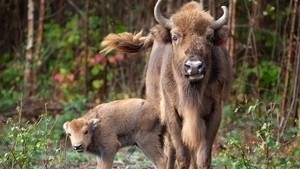
Baby Bison age 1 by Donnovan Wright

Baby Bison age 1 by Donnovan Wright
Two bison species exist globally: European and American bison. While similar in appearance, their ecological roles diverge dramatically. European bison are uniquely adapted to woodlands, feeding on higher plants and trees, whereas their American cousins graze the vast plains. Reintroducing European bison to the UK is a species revival and a restoration of the vital ecological functions lost centuries ago.
The European bison is a living link to our ancient past. It is a close relative of the Steppe bison that roamed prehistoric Britain. Their historical presence in the UK may not be well known, but their return is urgent; their role as 'ecosystem engineers' is needed to restore lost and threatened habitats. These awe-inspiring animals have the power to restore ecological balance and diversity that vanishes along with large herbivores.
Bison rejuvenate landscapes in ways no machinery or human intervention could. Their natural behaviours—grazing, dust bathing, and bark stripping—reshape woodland habitats, creating a mosaic of open areas and dense patches that encourage biodiversity. Forest canopies open, clearings emerge, and new growth takes root, providing shelter and sustenance for countless species, from insects and small mammals to birds. The presence of bison will enhance resilience to climate change, allowing species to adapt better. Compared to conventional grazers like sheep or cattle, their unique diet of bark and woody plants even lowers greenhouse gas emissions, making bison a sustainable option for conservation grazing.
The success of projects like the Kent Wildlife Trust’s Bison Reintroduction is an inspiring example of these animals' transformative power on ecosystems.
In 2022, European bison were reintroduced into Blean Woods near Canterbury, marking a historic step in the UK’s conservation efforts. The project has already seen promising results, with bison playing a pivotal role in reshaping the woodland, increasing biodiversity, and creating habitats for various species. This pioneering project highlights the potential for similar success in other parts of the UK, showcasing how reintroducing bison can build resilient, self-sustaining ecosystems that benefit nature and the surrounding community. It stands as a testament to bison's role in restoring landscapes and offers valuable insights into how these animals can be integral to rewilding efforts nationwide.
Wilder Blean Bison Project | Kent Wildlife Trust
Partnerships with local communities, conservationists, and landowners will gently guide us toward a new era of rewilding. The return of species like European bison and other vital wildlife promises to breathe new life into wild spaces, offering hope for a future where nature’s revival can flourish. While Derbyshire Wildlife Trust fully supports the long-term vision of reintroducing large herbivores like bison, there are no immediate plans. For now, we are carefully working to overcome challenges such as the fragmentation of habitats and fostering a deeper community understanding of re-wilding. As we take these thoughtful steps, we edge closer to a landscape where wildlife can thrive and nature can reclaim its balance, one partnership at a time.